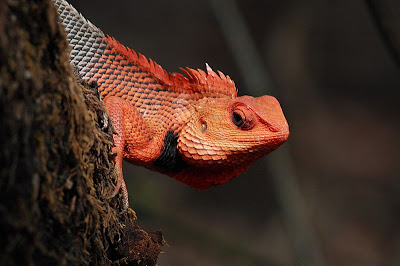"Elo Handsome" is the title given to this pic of a gorgeous green gecko with a red stripe along its face. What brilliant colors!
The vibrancy of this stunning lizard is akin to that found in rare paintings. Its head is orange... and it looks as if it is wearing a little bit of blue eye shadow!
This blue crested lizard seems to have taken a shine to the camera. Perhaps it's flirting a little!
Although fond of biting, this aggressive tokay gecko is also a colorful little devil in its orange polka dot suit! Perhaps its pattern serves as a warning. The males of this scorpion-eating species are, incidentally, more colorful than the females.
This spectacular image was taken at Kawaira in the Indian state of Karnataka. What a contrast between the big grey clouds, the rock and the bright yellow lizard.
On your marks, set, GO! This blue agama lizard, found in the desert around the Red Sea, looks ready to take on all comers in a race. In fact, male agama lizards get their most striking coloring during the mating season, with their heads (and sometimes tails) turning bright orange.
See! Here's another agama lizard – a red headed rock agama – found in Tsavo East National Park in Kenya. What a beauty!
This blue-tailed day gecko is beautiful with its deep blue skin and red dots – typical of this species' coloring. What's more, it has chosen a gorgeous tree to be photographed on in Mauritius, where it was spotted.
Sleek and elegant, this colorful lizard – a male peninsular rock agama lizard in its best breeding colors – was snapped basking in the midday sun in Hyderabad, India. It almost looks as though it's wearing shades!
This oriental garden lizard's coloring is so bright and sunny, it could be an ad for an orange juice drink! This is another lizard that's able to change the color of its body and head when it's breeding season, with duller tones replaced by far more eye-catching shades like these.
Another oriental garden lizard, proudly displaying the bright red throat, typical of the males in breeding season; this has led to its misnomer, the 'bloodsucker'.
We're not sure if this is the male or female of the species, but the purple coloring turns this iguana into a beauty either way. The color tones displayed by iguanas are often best viewed from afar.
Charlie, another iguana, is a big lad, seen here proudly posing for his photo at the Oslo Reptile Park. His rich coloring aside, the small scar you can see on his nose is self-inflicted – the result of him getting a bit feisty during mating season and throwing himself against walls and even his keepers!
With a colorful pale body fading into a brilliant yellow head, this distinctly-patterned blue collared lizard looks stunning against the desert background in Colorado National Monument. A North American favorite!
One very angry male European green lizard – he tried to bite everything in sight when caught for a close-up. The belligerent creature was then let go, back into the wild.
If this little chap is trying to blend in, it isn't doing a very good job with those bright yellow scales! Another gorgeous collared lizard.
This beautiful green veiled chameleon sums up how splendid this species can be with different shades of just one color. Chameleons are, of course, some of nature's great color changers, and the male veiled chameleon can shift from bright lime green to a duller red olive tone, depending on its emotional state and surroundings.
Once seen, the fiery colors of a panther chameleon are never forgotten, and this photograph of the species is surely one of the best. Male panther chameleons are more vibrantly colored than females, and when they encounter one another males will often color-change in shows of dominance.
Once seen, the fiery colors of a panther chameleon are never forgotten, and this photograph of the species is surely one of the best. Male panther chameleons are more vibrantly colored than females, and when they encounter one another males will often color-change in shows of dominance.
These images of lizards (this last one is a common green forest lizard) are just a peek into the colorful lives of some of these creatures. There are more to be discovered – and even more to be saved from habitat destruction.





















Catat Ulasan Blogger Facebook